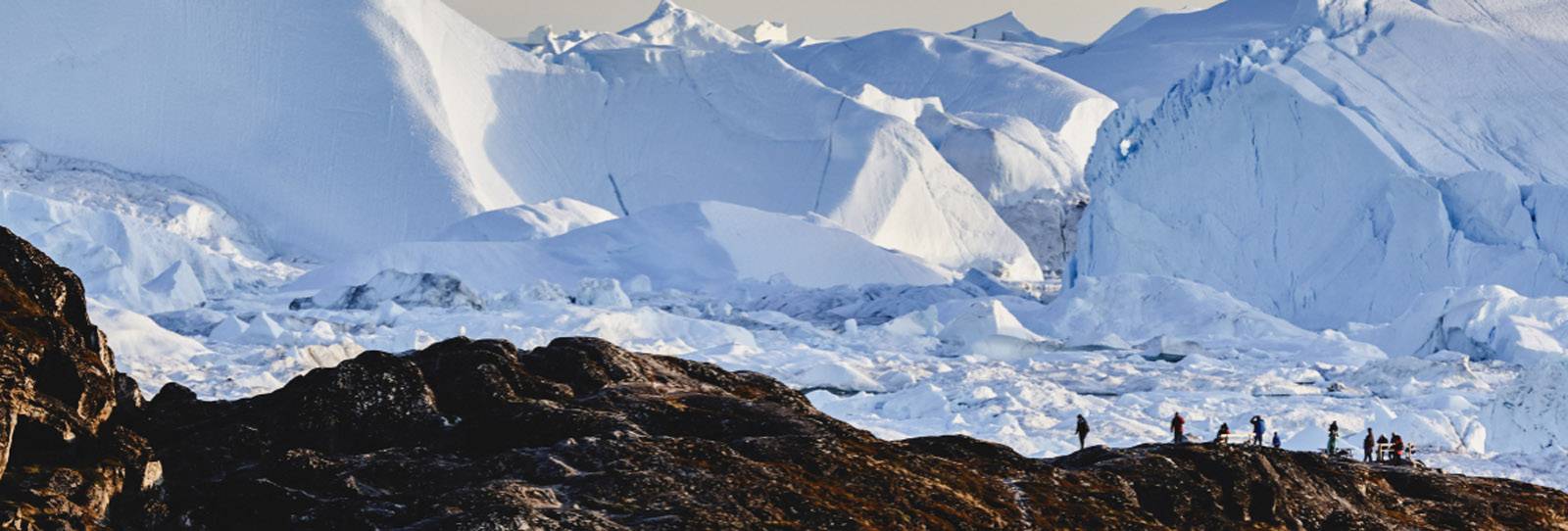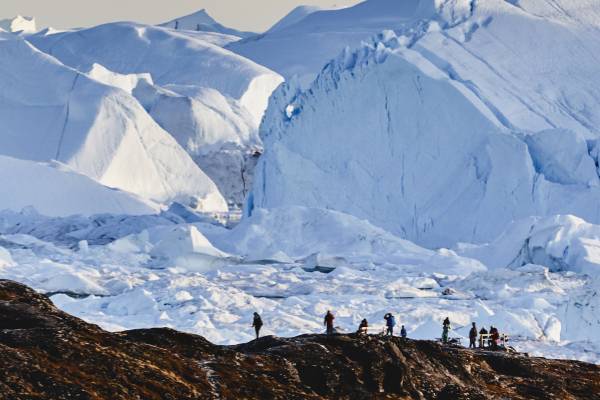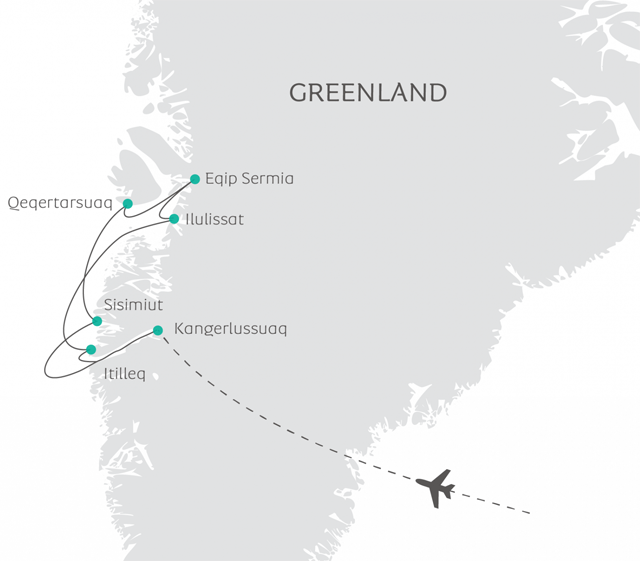HIGHLIGHTS
Traveling by sea is a magnificent way to experience Greenland. The places most worth seeing are situated along the dramatic coast line: small and colourful houses situated on the steep mountains sides down to a fjord, giant glaciers producing enormous icebergs, whilst whales and seals play in the sea.
DATES / RATES
Rates are listed per person
|
| Start Date | End Date | From EUR | From USD |
|---|
Rates are listed per person
|
| Start Date | End Date | From EUR | From USD |
|---|
ITINERARY
DAY
1: ICELAND OR DENMARK - KANGERLUSSUAQ. EMBARKATION
We
board our charter flight in Keflavík or Copenhagen bound for
Kangerlussuaq.
Upon
arrival in Kangerlussuaq in Greenland, we will be transported to the
small port located west of the airport, where our ship, Ocean Albatros,
will be anchored. Zodiacs will transfer us the short distance to the
ship, where you will be checked in to your stateroom. After the safety
drill, you will enjoy a dinner as Ocean Albatros'sets sail' through
the 160-kilometre Kangerlussuaq fjord.
DAY
2: SISIMIUT, GREENLAND'S SECOND-LARGEST CITY
After
breakfast, we arrive to the colourful town of Sisimiut, where we will
get an idea of what modern Greenland looks like. With 5,400
inhabitants, it is considered Greenland's second 'city'. People have
lived around Sisimiut on and off since 2,500 BC.
In
1756, Count Johan Ludvig Holstein, established a colony here and called
it "Holsteinsborg". The oldest part of Sisimiut's historic quarter
features town houses from this "Holsteinsborg" era, and the oldest
house in town dates back to 1756. One of the most culturally
significant buildings is the Blue Church, built in 1775.
Nowadays,
Sisimiut is an important place for education and industry, and local
factories process the bulk of Royal Greenland's fishing. The fish
processing plant is one of the largest of its kind in Greenland, and
one of the most modern in the world.
Our
city tour highlights include the historic colonial quarter, as well as
the museum and the beautiful church. Additionally, we will pay a visit
to the busy city centre for a glimpse of what daily life is like in
21st century Greenland. In the afternoon, our voyage will continue
northward.
As
evening falls, we will pass the Sisimiut Isortuat Fjord, the Nordre
Strømfjord settlements of Attu and Ikerasaarsuk, and the
small town of Kangaatsiaq. During the course of the bright night, we
will pass Aasiaat and proceed into the southern waters of Disko Bay.
Next, the ship's heading will be set for Disko Island, known for its
distinctive 1,000-meter/3,280 feet layered crags.
At
this point, we will be north of the Arctic Circle! Here, the nights are
bright and early risers can enjoy the sight of the icebergs on Disko
Bay as they squeeze out of the Ilulissat Icefjord and dance into the
frigid ocean waters.
DAY
3: QEQERTARSUAQ ON DISKO ISLAND, 'KAFFEMIK' IN A COMMUNITY CENTRE AND
EQIP SERMIA GLACIER
Our
next sojourn lies on the southern tip of the Disko Island, where Ocean
Atlantic will anchor in a protected natural harbour, which is named
Godhavn ('Good Harbour') in Danish, while its Greenlandic name,
Qeqertarsuaq, means 'The Big Island'.
Although
topographically quite different from mainland Greenland due to the
basalt characteristics of the Disko Island's mountains, Qeqertarsuaq
maintains a long, rich history and once served as one of the country's
important economic centres. From the 16th century, the community was
relatively prosperous and, in fact, considered the most important town
north of Nuuk until the mid-1900s, due in part to the area's sizeable
whale hunting population.
During
our visit, we will wander through town, paying a visit to the
characteristic octagonal church, nicknamed "God's Inkpot", as well as
to a local community center that will be hosting a traditional
Greenlandic "kaffemik", which can be best described as a friendly
gathering with coffee, cake and traditional dances and music.
Musicians
from Greenland originally played on a drum (qilaat) made from an oval
wooden frame covered with the bladder of a polar bear. Unlike other
drums, the qilaat was played by hitting the frame with a stick, not the
skin itself. This modest instrument was used for a variety of purposes,
including entertainment, exorcism and witchcraft.
After
the missionaries arrived, drum dancing was prohibited and later
replaced by part-singing of psalms and choral works, which today are
renowned for their particular Greenlandic sound. Today, drum dance is
used as entertainment in cultural events and on festive occasions.
Greenlandic
music is inspired and influenced by music from other cultures, like the
Danish and Inuit cultures, and more specifically, Dutch and Scottish
polka, American country and rock 'n' roll and even Hawaiian music,
which inspired the so-called Vaigat-musicians in Greenland in the 1950s
and 60s.
As
the day draws to a closing, Ocean Albatros will set a north-easterly
course bound for a magnificent natural highlight – the
enormous Eqip Sermia Glacier.
Situated
approximately 50 nautical miles north of Ilulissat, the Eqip Sermia
Glacier is renowned for its jaw-dropping beauty. Legendary arctic
explorers selected this location as a base for their studies. One such
explorer, the acclaimed Swiss glaciologist, Alfred de Quervain, used
the location as a base for his expeditions onto Greenland's inland ice
sheet over a century ago.
We
will sail as close as possible to the ice's edge – but at a
safe distance to avoid plunging blocks of ice and violent waves that
often result from the calving glacier.
DAY
4: ILULISSAT, CAPITAL OF THE ICEBERGS
Ilulissat
is possibly the most well located town in Greenland. The name simply
means 'icebergs' in Greenlandic, and the town's nickname is rightly
'the Iceberg Capital'.
In
Disko Bay, which is located just off the coast of Ilulissat, gigantic
icebergs linger in the freezing waters. These icebergs come from the
Icefjord, which is located a half hour's hike south of Ilulissat. These
impressive frozen structures are born some 70km/43,5 miles deeper into
the fjord by the enormous Sermeq Kujalleq glacier. This 10km/6
miles-wide glacier is the most productive glacier outside of
Antarctica; Whereas most glaciers only calve at a rate of approximately
a metre/three feet a day, the Ilulissat glacier calves at a rate of
25m/82 feet per day. The icebergs produced by the glacier represent
more than 10% of all icebergs in Greenland, corresponding to 20 million
tonnes/22 million us tons of ice per day!
These
facts, together with the fjord's unforgettable scenery, have secured
the Icefjord a place on UNESCO's World Heritage List.
During
the more than 250 years that have passed since the establishment of
Ilulissat, the town has steadily flourished. Today, Ilulissat is
Greenland's third largest town, with more than 4,500 inhabitants. The
town is very vibrant, welcoming and lively with a wide range of
cultural attractions, according to Greenlandic standards.
The
legendary polar explorer, Knud Rasmussen, and his good friend,
Jørgen Brønlund, were both born in Ilulissat.
On
this day, you will also have the opportunity to join a boat trip to the
Icefjord (not included). The journey takes about two and a half hours
in total, a great opportunity to take a closer look at the amazing
ice-sculpted scenery.
The
trip is definitely something out of the ordinary and a great natural
experience that you will remember for years to come – but be
sure to have warm clothing on!
If
a hike or a trip by boat does not present enough excitement, there is
also an opportunity to arrange a helicopter ride over the Icefjord (not
included).
Please
note the boat and helicopter excursions to the Icefjord are not
included in the general tour price. Furthermore, the helicopter
excursion must be booked in advance. Refer to Price Information for
more details.
In
the evening, we will cruise southward from "the Iceberg Capital",
leaving lovely Disko Bay behind us as we part.
DAY
5: THE SETTLEMENT OF SARFANNGUIT
The
settlement of Sarfannguit, which translates into 'the place of the
little stream" an appropriate name for a settlement nestled at the
foothills of the mountains and glaciers in the distant backcountry. The
settlement's slightly more than 100 residents live off hunting,
trapping and fishing, most often in pursuit of arctic char, reindeer
and musk oxen.
Although
Sarfannguit is quite remote, it lies within a few hours from Sisimiut,
the second-largest town in Greenland. The accessibility to such a large
town provides an indispensable economic benefit to a small community
like Sarfannguit.
A
stroll through the settlement offers insight into rural life in today's
Greenland, where modern conveniences and technological advancements,
such as internet and smart phones have become commonplace, yet locals
still place great value on important customs and preserving their
traditions and their Inuit heritage.
We
will continue our journey toward the fjord of Kangerlussuaq, also known
as Sondre Stromfjord. Especially the first part of the fjord gives a
great opportunity to enjoy an impressive passage with panoramic views
of high mountains and deep valleys.
DAY
6: KANGERLUSSUAQ. AIR TO ICELAND OR DENMARK
During
the night, we will have completed our passage through the
160-kilometer/100 mile Kangerlussuaq Fjord. After breakfast aboard the
ship, we will bid farewell to the ship's staff and the Zodiac boats
will shuttle us to shore.
Due
to Kangerlussuaq's military history and present-day role as an
important air travel hub, Kangerlussuaq remains fairly isolated from
Greenland's rich cultural traditions, in comparison to other regions.
While you still find cultural experiences when visiting Kangerlussuaq,
the most impressive attraction is the surrounding nature, which is just
beckoning to be explored.
It
is not difficult for one to see that Kangerlussuaq's landscape has
largely been shaped by the last glaciation period, often known simply
as the "Ice Age," some 18,000 years ago. The mountains are rounded and
soft, and many meltwater lakes remain. From the inland ice sheet, best
known as the Greenland Ice Sheet, the meltwater cuts its way through
the porous moraine landscape and flows into Kangerlussuaq Fjord.
Kangerlussuaq's
present-day climate is largely influenced by its well-sheltered
location between Greenland's Ice Sheet, the fjord and mountains. This
contributes to its stable conditions, minimal cloud cover and roughly
300 clear nights per year.
This
close proximity to the Ice Sheet, combined with the continental
climate, is also of great significance to the local conditions. The dry
climate, combined with warm winds that "fall" from the Ice Sheet, can
result in temperatures that jump up to 30°C (86°F) in
the summer, but then fall to an extreme -40°C (-40°F)
in winter, making it the coldest inhabited area in Greenland.
In
Kangerlussuaq, we offer an optional excursion to the beautiful Reindeer
Glacier. The duration of the excursion is about four hours.
Please
note that the excursion is not included in the general tour price.
Refer to Price Information for more details. We do not recommend the
excursion for people who suffer from bad necks or backs, as the gravel
road to the ice sheet is occasionally bumpy and uneven.
As
our time in Greenland concludes, after breakfast and checkout, your
arctic adventure will have concluded. We hope to see you again soon! We
fly from Kangerlussuaq to Keflavik Airport, Iceland or Copenhagen,
Denmark.
 (Click image to view Ship details)
(Click image to view Ship details)
WHAT'S INCLUDED
- 8-day/7-night
cruise on Ocean Albatros in a shared outside double room with a private
bathroom in the category chosen
- Flights:
Iceland or Denmark – Kangerlussuaq round trip
- Local
transport in Kangerlussuaq on days 1 and 8
- English-speaking
expedition staff
- Guided
walks with the expedition team
- Nature
hikes and Zodiac cruises per itinerary
- Information
briefings and lectures by the expedition team
- City
tours in Sisimiut, Qeqertarsuaq, Uummannaq and Ilulissat
- Museum
visits in Sisimiut, Qeqertarsuaq and Ilulissat
- Church
visits in Qeqertarsuaq and Ilulissat
- 'Kaffemik'
visit in Qeqertarsuaq
- Special
photo workshop
- Full
board on the ship
- Dinner
drink package
- Free
coffee, tea, and afternoon snacks on the ship
- Welcome
and farewell cocktails
- Taxes,
tariffs, and landing fees
- Digital
visual journal link after the voyage, including voyage log, gallery,
species list, and more
EXCLUSIONS
- Extra
excursions and activities not mentioned in the itinerary
- Single
room supplement and cabin upgrades
- Meals
not on board the ship
- Beverages
(other than coffee and tea and dinner-drink package)
- Tips
for the crew (we recommend USD 14 per person per day)
- Personal
expenses
- Travel,
cancellation, and senior insurance
- Anything
not mentioned under ’Inclusions’
ADVENTURE
OPTIONS
- Zodiac
Cruises
- Kayaking
- USD 250
- Lectures
- Boat
Trips
- Icefjord
Flight Sightseeing







